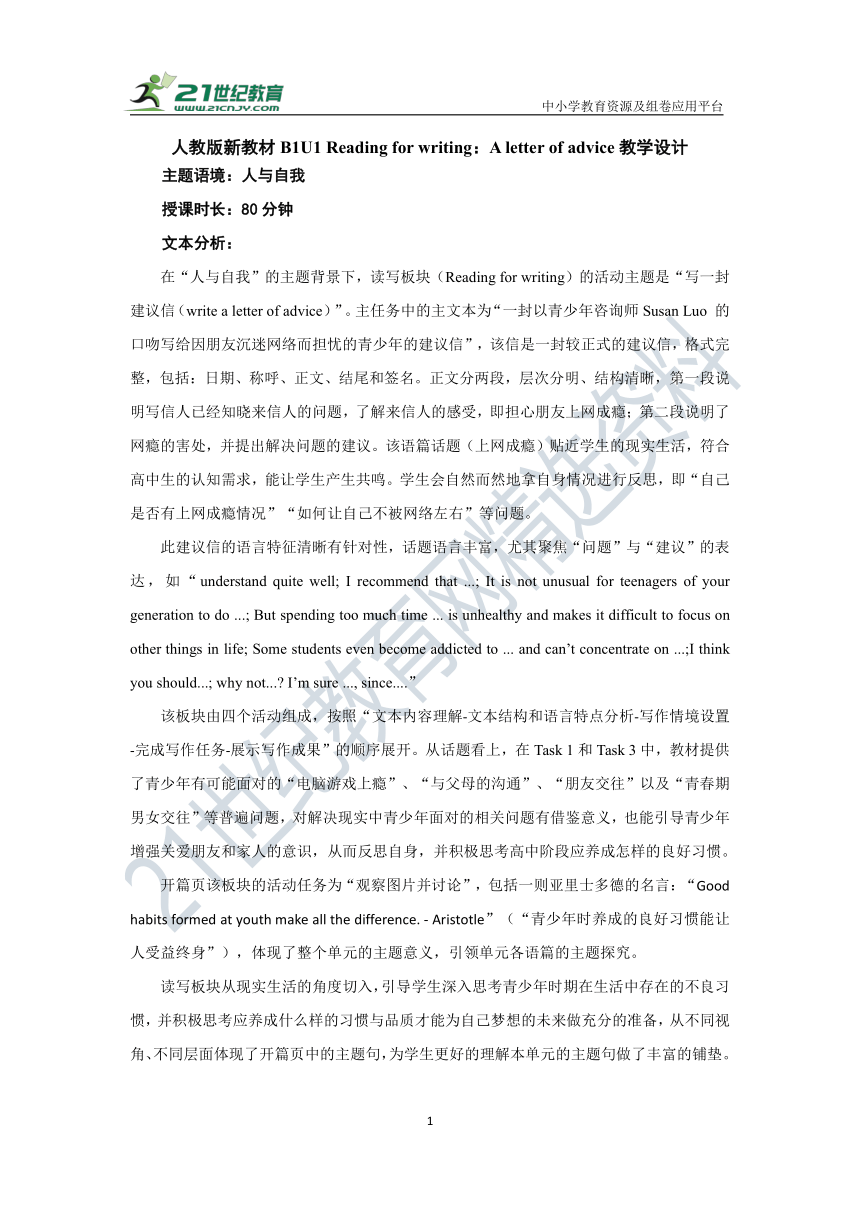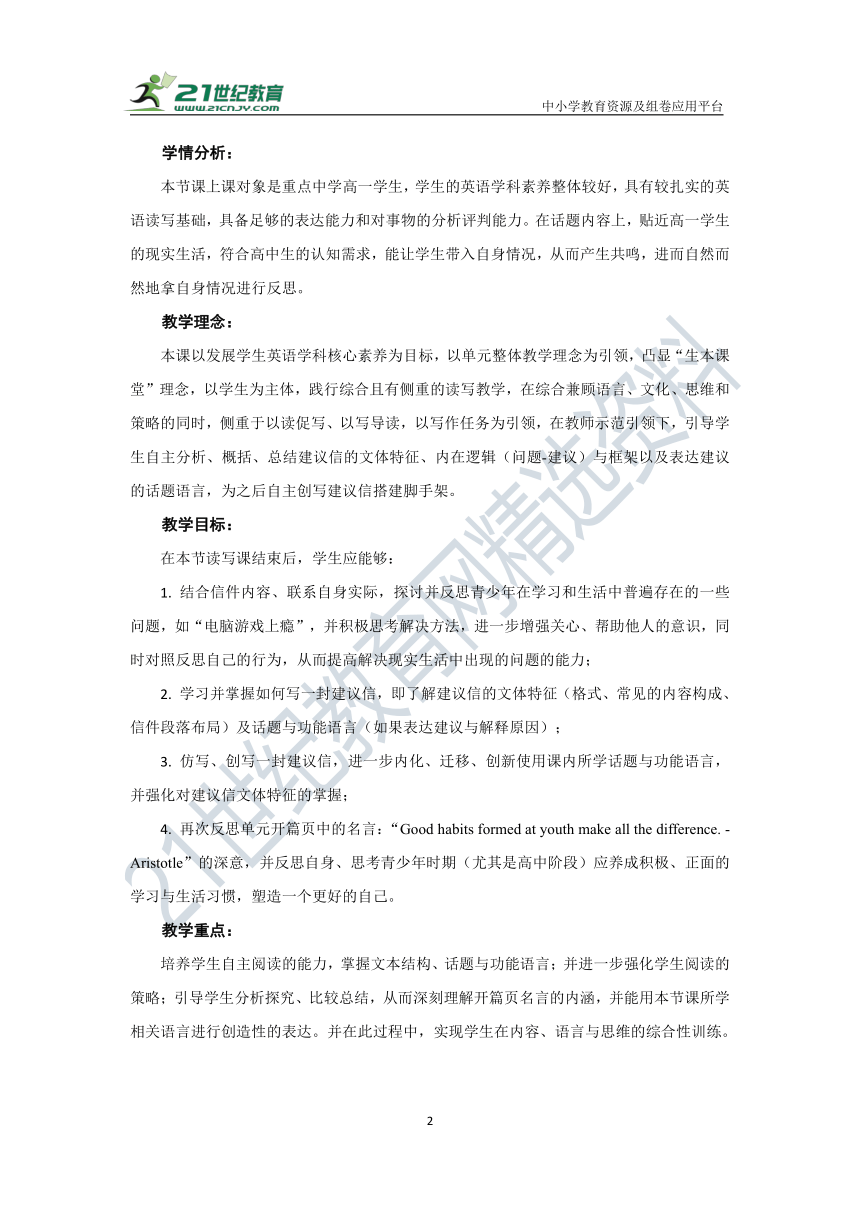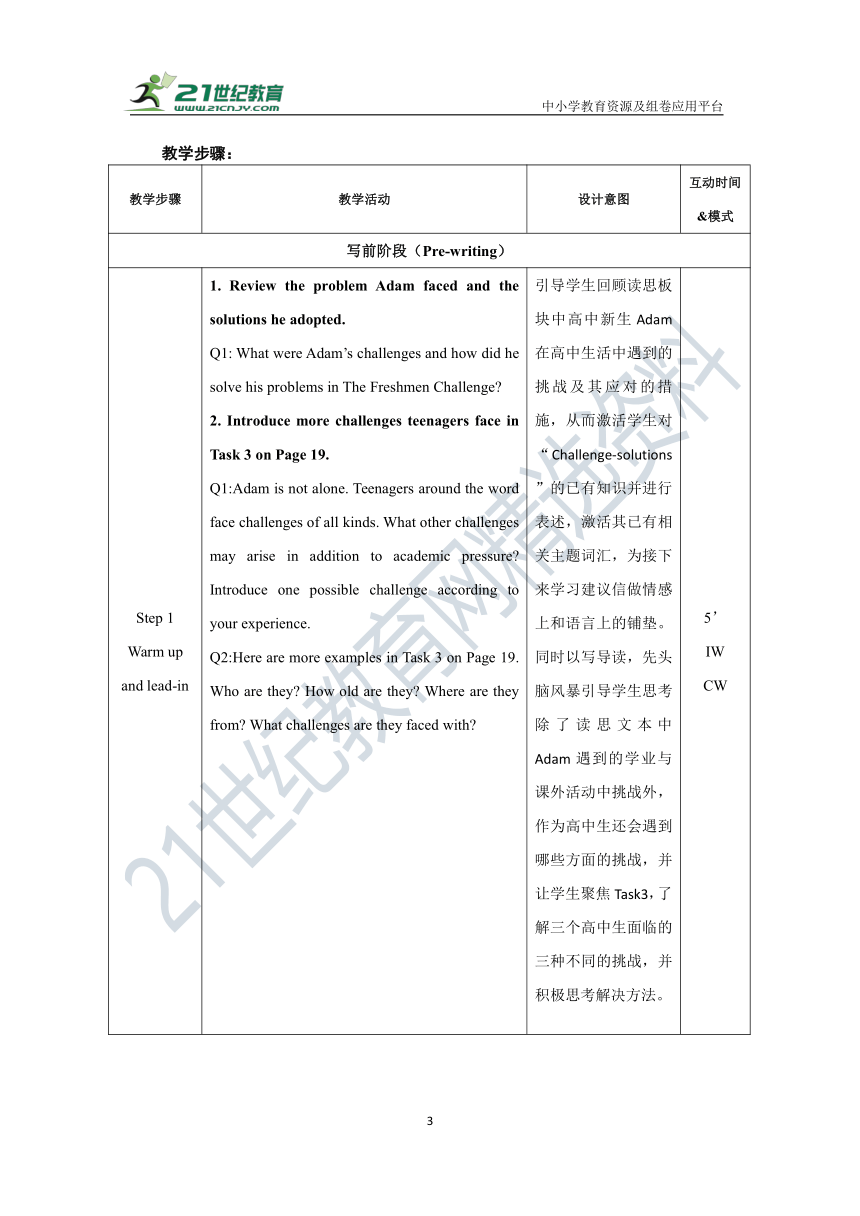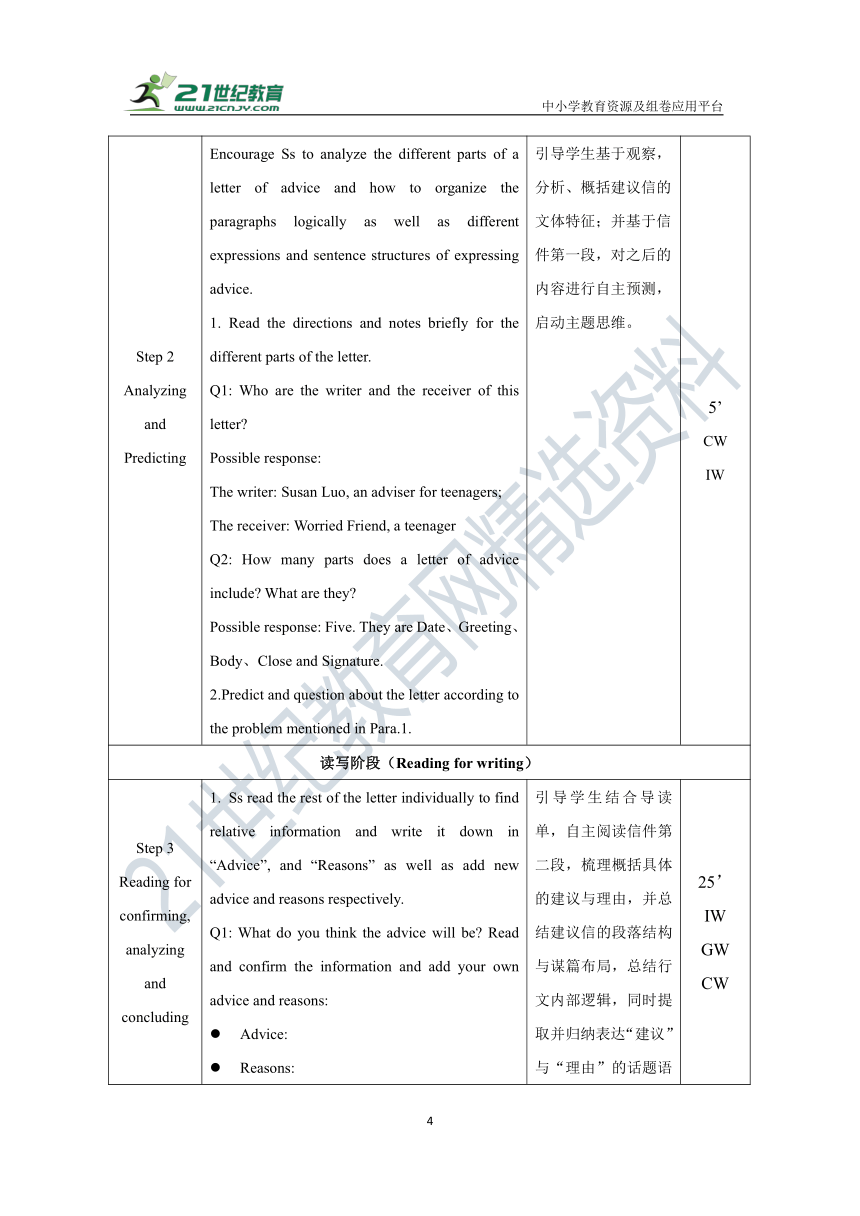人教版(2019)必修第一册 Unit 1 Teenage life 读思板块教案
文档属性
| 名称 | 人教版(2019)必修第一册 Unit 1 Teenage life 读思板块教案 |

|
|
| 格式 | docx | ||
| 文件大小 | 151.8KB | ||
| 资源类型 | 试卷 | ||
| 版本资源 | 人教版(2019) | ||
| 科目 | 英语 | ||
| 更新时间 | 2024-09-21 15:04:49 | ||
图片预览




文档简介
中小学教育资源及组卷应用平台
人教版新教材B1U1 Reading for writing:A letter of advice教学设计
主题语境:人与自我
授课时长:80分钟
文本分析:
在“人与自我”的主题背景下,读写板块(Reading for writing)的活动主题是“写一封建议信(write a letter of advice)”。主任务中的主文本为“一封以青少年咨询师Susan Luo 的口吻写给因朋友沉迷网络而担忧的青少年的建议信”,该信是一封较正式的建议信,格式完整,包括:日期、称呼、正文、结尾和签名。正文分两段,层次分明、结构清晰,第一段说明写信人已经知晓来信人的问题,了解来信人的感受,即担心朋友上网成瘾;第二段说明了网瘾的害处,并提出解决问题的建议。该语篇话题(上网成瘾)贴近学生的现实生活,符合高中生的认知需求,能让学生产生共鸣。学生会自然而然地拿自身情况进行反思,即“自己是否有上网成瘾情况”“如何让自己不被网络左右”等问题。
此建议信的语言特征清晰有针对性,话题语言丰富,尤其聚焦“问题”与“建议”的表达,如“understand quite well; I recommend that ...; It is not unusual for teenagers of your generation to do ...; But spending too much time ... is unhealthy and makes it difficult to focus on other things in life; Some students even become addicted to ... and can’t concentrate on ...;I think you should...; why not... I’m sure ..., since....”
该板块由四个活动组成,按照“文本内容理解-文本结构和语言特点分析-写作情境设置-完成写作任务-展示写作成果”的顺序展开。从话题看上,在Task 1和Task 3中,教材提供了青少年有可能面对的“电脑游戏上瘾”、“与父母的沟通”、“朋友交往”以及“青春期男女交往”等普遍问题,对解决现实中青少年面对的相关问题有借鉴意义,也能引导青少年增强关爱朋友和家人的意识,从而反思自身,并积极思考高中阶段应养成怎样的良好习惯。
开篇页该板块的活动任务为“观察图片并讨论”,包括一则亚里士多德的名言:“Good habits formed at youth make all the difference. - Aristotle”(“青少年时养成的良好习惯能让人受益终身”),体现了整个单元的主题意义,引领单元各语篇的主题探究。
读写板块从现实生活的角度切入,引导学生深入思考青少年时期在生活中存在的不良习惯,并积极思考应养成什么样的习惯与品质才能为自己梦想的未来做充分的准备,从不同视角、不同层面体现了开篇页中的主题句,为学生更好的理解本单元的主题句做了丰富的铺垫。
学情分析:
本节课上课对象是重点中学高一学生,学生的英语学科素养整体较好,具有较扎实的英语读写基础,具备足够的表达能力和对事物的分析评判能力。在话题内容上,贴近高一学生的现实生活,符合高中生的认知需求,能让学生带入自身情况,从而产生共鸣,进而自然而然地拿自身情况进行反思。
教学理念:
本课以发展学生英语学科核心素养为目标,以单元整体教学理念为引领,凸显“生本课堂”理念,以学生为主体,践行综合且有侧重的读写教学,在综合兼顾语言、文化、思维和策略的同时,侧重于以读促写、以写导读,以写作任务为引领,在教师示范引领下,引导学生自主分析、概括、总结建议信的文体特征、内在逻辑(问题-建议)与框架以及表达建议的话题语言,为之后自主创写建议信搭建脚手架。
教学目标:
在本节读写课结束后,学生应能够:
结合信件内容、联系自身实际,探讨并反思青少年在学习和生活中普遍存在的一些问题,如“电脑游戏上瘾”,并积极思考解决方法,进一步增强关心、帮助他人的意识,同时对照反思自己的行为,从而提高解决现实生活中出现的问题的能力;
学习并掌握如何写一封建议信,即了解建议信的文体特征(格式、常见的内容构成、信件段落布局)及话题与功能语言(如果表达建议与解释原因);
仿写、创写一封建议信,进一步内化、迁移、创新使用课内所学话题与功能语言,并强化对建议信文体特征的掌握;
再次反思单元开篇页中的名言:“Good habits formed at youth make all the difference. - Aristotle”的深意,并反思自身、思考青少年时期(尤其是高中阶段)应养成积极、正面的学习与生活习惯,塑造一个更好的自己。
教学重点:
培养学生自主阅读的能力,掌握文本结构、话题与功能语言;并进一步强化学生阅读的策略;引导学生分析探究、比较总结,从而深刻理解开篇页名言的内涵,并能用本节课所学相关语言进行创造性的表达。并在此过程中,实现学生在内容、语言与思维的综合性训练。
教学步骤:
教学步骤 教学活动 设计意图 互动时间&模式
写前阶段(Pre-writing)
Step 1 Warm up and lead-in 1. Review the problem Adam faced and the solutions he adopted. Q1: What were Adam’s challenges and how did he solve his problems in The Freshmen Challenge 2. Introduce more challenges teenagers face in Task 3 on Page 19. Q1:Adam is not alone. Teenagers around the word face challenges of all kinds. What other challenges may arise in addition to academic pressure Introduce one possible challenge according to your experience. Q2:Here are more examples in Task 3 on Page 19. Who are they How old are they Where are they from What challenges are they faced with 引导学生回顾读思板块中高中新生Adam在高中生活中遇到的挑战及其应对的措施,从而激活学生对“Challenge-solutions”的已有知识并进行表述,激活其已有相关主题词汇,为接下来学习建议信做情感上和语言上的铺垫。同时以写导读,先头脑风暴引导学生思考除了读思文本中Adam遇到的学业与课外活动中挑战外,作为高中生还会遇到哪些方面的挑战,并让学生聚焦Task3,了解三个高中生面临的三种不同的挑战,并积极思考解决方法。 5’ IW CW
Step 2 Analyzing and Predicting Encourage Ss to analyze the different parts of a letter of advice and how to organize the paragraphs logically as well as different expressions and sentence structures of expressing advice. Read the directions and notes briefly for the different parts of the letter. Q1: Who are the writer and the receiver of this letter Possible response: The writer: Susan Luo, an adviser for teenagers; The receiver: Worried Friend, a teenager Q2: How many parts does a letter of advice include What are they Possible response: Five. They are Date、Greeting、Body、Close and Signature. 2.Predict and question about the letter according to the problem mentioned in Para.1. 引导学生基于观察,分析、概括建议信的文体特征;并基于信件第一段,对之后的内容进行自主预测,启动主题思维。 5’ CW IW
读写阶段(Reading for writing)
Step 3 Reading for confirming, analyzing and concluding Ss read the rest of the letter individually to find relative information and write it down in “Advice”, and “Reasons” as well as add new advice and reasons respectively. Q1: What do you think the advice will be Read and confirm the information and add your own advice and reasons: Advice: Reasons: Task 1: Mini-writing: Suppose you were the Susan Luo and please write 1-2 more pieces of advice to the worried friend. Q2:How do we write a letter of advice Structure: problem(s)---advice---reasons Language: 引导学生结合导读单,自主阅读信件第二段,梳理概括具体的建议与理由,并总结建议信的段落结构与谋篇布局,总结行文内部逻辑,同时提取并归纳表达“建议”与“理由”的话题语言。同时引导学生以Susan Luod的身份试着给the worried friend提出自己的建议与理由,并开展微情景仿写,从而内化“如何提建议”与“解释理由”的写作方法;并在情感上增强关心、帮助他人的意识和能力。在此过程中强化学生获取、整合相关信息的能力,培养其逻辑思维、批判思维与创新思维能力。 25’ IW GW CW
Step 4 After reading writing Task 1: Group discussion Choose one of the teenagers and discuss his/her problem in the Task 3. List possible suggestions and reasons as many as possible. Task 2: Write a letter of advice to one of the teenagers in Task 3 首先让学生以小组活动,选择其中一个高中生所面临的困境开展头脑风暴,为之后的创写奠定内容基础;基于课堂关于“如何写一封建议信”的“文体特征”、“篇章结构”与“话题与功能语言”的脚手架后,结合Task3的任务,开展自主创写建议信。 20’ IW CW GW
Step 5 Sharing and assessing Ss first make a checklist about a good letter of advice through discussion. Ss will share their writings and assess the article(s) according to the checklist made. 引导学生基于课内主文本建议信所学文体特征、框架结构与话题语言,梳理、总结、师生共同制定评价一封好的建议信的要点;然后请学生分享其建议信,并进行教师引导下的师生与生生互评,最后如有时间可进行针对性的修改。此过程是为了进一步内化、迁移、创新。 20’ IW GW CW
读后阶段(Post-writing)
Step 6 Critical thinking What do you think is necessary for a senior high school student when facing challenging situations What is your understanding of the sentence “Good habits formed at youth make all the difference. - Aristotle” 引导学生联结生活、联系自我,通过个性化思考或结合小组讨论,基于课堂所学,再次联结开篇页的主题句进行更进一步地反思与探讨,个性化地深入思考主题意义并表达观点。培养学生逻辑思维和批判性思维、提高小组合作学习和解决问题的能力;并帮助学生积极面对生活中“与父母的沟通”、“朋友交往” 以及 “青春期男女交往”等方面遇到的问题,树立良好的心态。 5’ IW CW
Step 7 Assignment Polish your writings according to what you’ve learned and the checklist. Li Ping is anxious as a freshman and wrote a letter to your, asking for your advice on the senior high school life. Please write a letter of advice to him. You may refer to what you learned in The Freshman Challenge and A letter of advice. 学生结合课堂制定的评价标准, 进一步修改、强化、内化所学。
备注:Ss: Students IW: Individual work GW: Group work CW: Class work
板书设计:
(
Beginning:
describe the problem clearly and briefly. (offer comfort and understanding)
Body:
1. offer advice and its supporting reasons. (The advice should be related to the problem. )
2. give comfort and encouragement.
Ending:
offer good wishes.
) (
Date
)A letter of advice
(
Greeting
)
(
Main body
)
(
Close
)
(
Signature
)
(
Making suggestions
:
I recommend you doing...;
It is highly recommended that...;
Doing sth is highly/strongly recommended;
My advice/suggestion/recommendation is/would be...
I’d like to suggest/advice that...;
I think you should...;
It might be a good idea to...; You’d better...;
Why not... ; Why don’t you... ; How about... What do you think... ;
)
(
Language Bank
) (
Showing understandings
:
I am sorry to hear/know/learn that...;
I know/understand how it feels to...;
It happens to everyone.;
I know you didn’t mean to...;
Everyone will have one of those periods when things seem to be going wrong.
) (
Showing reasons
:
It’s not unusual for…to do…;
But …is unhealthy and makes it difficult to …;
Some… even become addicted to…and cannot concentrate on…
It is because...
)
7
人教版新教材B1U1 Reading for writing:A letter of advice教学设计
主题语境:人与自我
授课时长:80分钟
文本分析:
在“人与自我”的主题背景下,读写板块(Reading for writing)的活动主题是“写一封建议信(write a letter of advice)”。主任务中的主文本为“一封以青少年咨询师Susan Luo 的口吻写给因朋友沉迷网络而担忧的青少年的建议信”,该信是一封较正式的建议信,格式完整,包括:日期、称呼、正文、结尾和签名。正文分两段,层次分明、结构清晰,第一段说明写信人已经知晓来信人的问题,了解来信人的感受,即担心朋友上网成瘾;第二段说明了网瘾的害处,并提出解决问题的建议。该语篇话题(上网成瘾)贴近学生的现实生活,符合高中生的认知需求,能让学生产生共鸣。学生会自然而然地拿自身情况进行反思,即“自己是否有上网成瘾情况”“如何让自己不被网络左右”等问题。
此建议信的语言特征清晰有针对性,话题语言丰富,尤其聚焦“问题”与“建议”的表达,如“understand quite well; I recommend that ...; It is not unusual for teenagers of your generation to do ...; But spending too much time ... is unhealthy and makes it difficult to focus on other things in life; Some students even become addicted to ... and can’t concentrate on ...;I think you should...; why not... I’m sure ..., since....”
该板块由四个活动组成,按照“文本内容理解-文本结构和语言特点分析-写作情境设置-完成写作任务-展示写作成果”的顺序展开。从话题看上,在Task 1和Task 3中,教材提供了青少年有可能面对的“电脑游戏上瘾”、“与父母的沟通”、“朋友交往”以及“青春期男女交往”等普遍问题,对解决现实中青少年面对的相关问题有借鉴意义,也能引导青少年增强关爱朋友和家人的意识,从而反思自身,并积极思考高中阶段应养成怎样的良好习惯。
开篇页该板块的活动任务为“观察图片并讨论”,包括一则亚里士多德的名言:“Good habits formed at youth make all the difference. - Aristotle”(“青少年时养成的良好习惯能让人受益终身”),体现了整个单元的主题意义,引领单元各语篇的主题探究。
读写板块从现实生活的角度切入,引导学生深入思考青少年时期在生活中存在的不良习惯,并积极思考应养成什么样的习惯与品质才能为自己梦想的未来做充分的准备,从不同视角、不同层面体现了开篇页中的主题句,为学生更好的理解本单元的主题句做了丰富的铺垫。
学情分析:
本节课上课对象是重点中学高一学生,学生的英语学科素养整体较好,具有较扎实的英语读写基础,具备足够的表达能力和对事物的分析评判能力。在话题内容上,贴近高一学生的现实生活,符合高中生的认知需求,能让学生带入自身情况,从而产生共鸣,进而自然而然地拿自身情况进行反思。
教学理念:
本课以发展学生英语学科核心素养为目标,以单元整体教学理念为引领,凸显“生本课堂”理念,以学生为主体,践行综合且有侧重的读写教学,在综合兼顾语言、文化、思维和策略的同时,侧重于以读促写、以写导读,以写作任务为引领,在教师示范引领下,引导学生自主分析、概括、总结建议信的文体特征、内在逻辑(问题-建议)与框架以及表达建议的话题语言,为之后自主创写建议信搭建脚手架。
教学目标:
在本节读写课结束后,学生应能够:
结合信件内容、联系自身实际,探讨并反思青少年在学习和生活中普遍存在的一些问题,如“电脑游戏上瘾”,并积极思考解决方法,进一步增强关心、帮助他人的意识,同时对照反思自己的行为,从而提高解决现实生活中出现的问题的能力;
学习并掌握如何写一封建议信,即了解建议信的文体特征(格式、常见的内容构成、信件段落布局)及话题与功能语言(如果表达建议与解释原因);
仿写、创写一封建议信,进一步内化、迁移、创新使用课内所学话题与功能语言,并强化对建议信文体特征的掌握;
再次反思单元开篇页中的名言:“Good habits formed at youth make all the difference. - Aristotle”的深意,并反思自身、思考青少年时期(尤其是高中阶段)应养成积极、正面的学习与生活习惯,塑造一个更好的自己。
教学重点:
培养学生自主阅读的能力,掌握文本结构、话题与功能语言;并进一步强化学生阅读的策略;引导学生分析探究、比较总结,从而深刻理解开篇页名言的内涵,并能用本节课所学相关语言进行创造性的表达。并在此过程中,实现学生在内容、语言与思维的综合性训练。
教学步骤:
教学步骤 教学活动 设计意图 互动时间&模式
写前阶段(Pre-writing)
Step 1 Warm up and lead-in 1. Review the problem Adam faced and the solutions he adopted. Q1: What were Adam’s challenges and how did he solve his problems in The Freshmen Challenge 2. Introduce more challenges teenagers face in Task 3 on Page 19. Q1:Adam is not alone. Teenagers around the word face challenges of all kinds. What other challenges may arise in addition to academic pressure Introduce one possible challenge according to your experience. Q2:Here are more examples in Task 3 on Page 19. Who are they How old are they Where are they from What challenges are they faced with 引导学生回顾读思板块中高中新生Adam在高中生活中遇到的挑战及其应对的措施,从而激活学生对“Challenge-solutions”的已有知识并进行表述,激活其已有相关主题词汇,为接下来学习建议信做情感上和语言上的铺垫。同时以写导读,先头脑风暴引导学生思考除了读思文本中Adam遇到的学业与课外活动中挑战外,作为高中生还会遇到哪些方面的挑战,并让学生聚焦Task3,了解三个高中生面临的三种不同的挑战,并积极思考解决方法。 5’ IW CW
Step 2 Analyzing and Predicting Encourage Ss to analyze the different parts of a letter of advice and how to organize the paragraphs logically as well as different expressions and sentence structures of expressing advice. Read the directions and notes briefly for the different parts of the letter. Q1: Who are the writer and the receiver of this letter Possible response: The writer: Susan Luo, an adviser for teenagers; The receiver: Worried Friend, a teenager Q2: How many parts does a letter of advice include What are they Possible response: Five. They are Date、Greeting、Body、Close and Signature. 2.Predict and question about the letter according to the problem mentioned in Para.1. 引导学生基于观察,分析、概括建议信的文体特征;并基于信件第一段,对之后的内容进行自主预测,启动主题思维。 5’ CW IW
读写阶段(Reading for writing)
Step 3 Reading for confirming, analyzing and concluding Ss read the rest of the letter individually to find relative information and write it down in “Advice”, and “Reasons” as well as add new advice and reasons respectively. Q1: What do you think the advice will be Read and confirm the information and add your own advice and reasons: Advice: Reasons: Task 1: Mini-writing: Suppose you were the Susan Luo and please write 1-2 more pieces of advice to the worried friend. Q2:How do we write a letter of advice Structure: problem(s)---advice---reasons Language: 引导学生结合导读单,自主阅读信件第二段,梳理概括具体的建议与理由,并总结建议信的段落结构与谋篇布局,总结行文内部逻辑,同时提取并归纳表达“建议”与“理由”的话题语言。同时引导学生以Susan Luod的身份试着给the worried friend提出自己的建议与理由,并开展微情景仿写,从而内化“如何提建议”与“解释理由”的写作方法;并在情感上增强关心、帮助他人的意识和能力。在此过程中强化学生获取、整合相关信息的能力,培养其逻辑思维、批判思维与创新思维能力。 25’ IW GW CW
Step 4 After reading writing Task 1: Group discussion Choose one of the teenagers and discuss his/her problem in the Task 3. List possible suggestions and reasons as many as possible. Task 2: Write a letter of advice to one of the teenagers in Task 3 首先让学生以小组活动,选择其中一个高中生所面临的困境开展头脑风暴,为之后的创写奠定内容基础;基于课堂关于“如何写一封建议信”的“文体特征”、“篇章结构”与“话题与功能语言”的脚手架后,结合Task3的任务,开展自主创写建议信。 20’ IW CW GW
Step 5 Sharing and assessing Ss first make a checklist about a good letter of advice through discussion. Ss will share their writings and assess the article(s) according to the checklist made. 引导学生基于课内主文本建议信所学文体特征、框架结构与话题语言,梳理、总结、师生共同制定评价一封好的建议信的要点;然后请学生分享其建议信,并进行教师引导下的师生与生生互评,最后如有时间可进行针对性的修改。此过程是为了进一步内化、迁移、创新。 20’ IW GW CW
读后阶段(Post-writing)
Step 6 Critical thinking What do you think is necessary for a senior high school student when facing challenging situations What is your understanding of the sentence “Good habits formed at youth make all the difference. - Aristotle” 引导学生联结生活、联系自我,通过个性化思考或结合小组讨论,基于课堂所学,再次联结开篇页的主题句进行更进一步地反思与探讨,个性化地深入思考主题意义并表达观点。培养学生逻辑思维和批判性思维、提高小组合作学习和解决问题的能力;并帮助学生积极面对生活中“与父母的沟通”、“朋友交往” 以及 “青春期男女交往”等方面遇到的问题,树立良好的心态。 5’ IW CW
Step 7 Assignment Polish your writings according to what you’ve learned and the checklist. Li Ping is anxious as a freshman and wrote a letter to your, asking for your advice on the senior high school life. Please write a letter of advice to him. You may refer to what you learned in The Freshman Challenge and A letter of advice. 学生结合课堂制定的评价标准, 进一步修改、强化、内化所学。
备注:Ss: Students IW: Individual work GW: Group work CW: Class work
板书设计:
(
Beginning:
describe the problem clearly and briefly. (offer comfort and understanding)
Body:
1. offer advice and its supporting reasons. (The advice should be related to the problem. )
2. give comfort and encouragement.
Ending:
offer good wishes.
) (
Date
)A letter of advice
(
Greeting
)
(
Main body
)
(
Close
)
(
Signature
)
(
Making suggestions
:
I recommend you doing...;
It is highly recommended that...;
Doing sth is highly/strongly recommended;
My advice/suggestion/recommendation is/would be...
I’d like to suggest/advice that...;
I think you should...;
It might be a good idea to...; You’d better...;
Why not... ; Why don’t you... ; How about... What do you think... ;
)
(
Language Bank
) (
Showing understandings
:
I am sorry to hear/know/learn that...;
I know/understand how it feels to...;
It happens to everyone.;
I know you didn’t mean to...;
Everyone will have one of those periods when things seem to be going wrong.
) (
Showing reasons
:
It’s not unusual for…to do…;
But …is unhealthy and makes it difficult to …;
Some… even become addicted to…and cannot concentrate on…
It is because...
)
7
